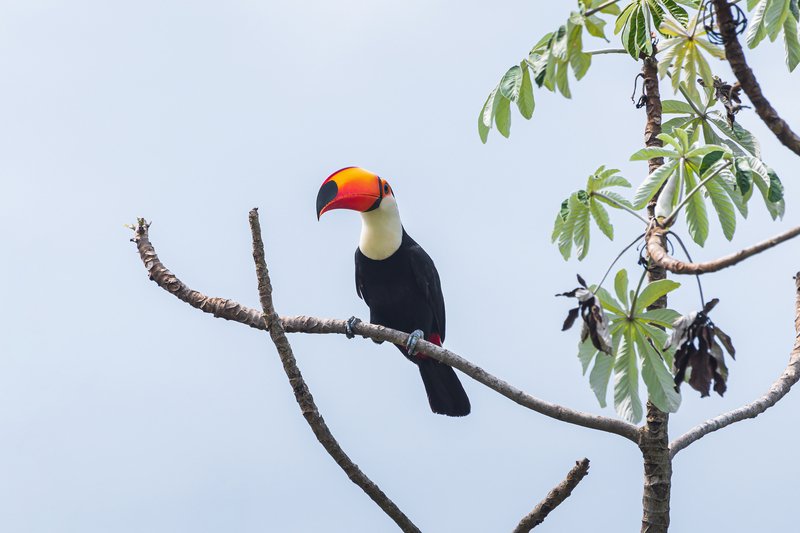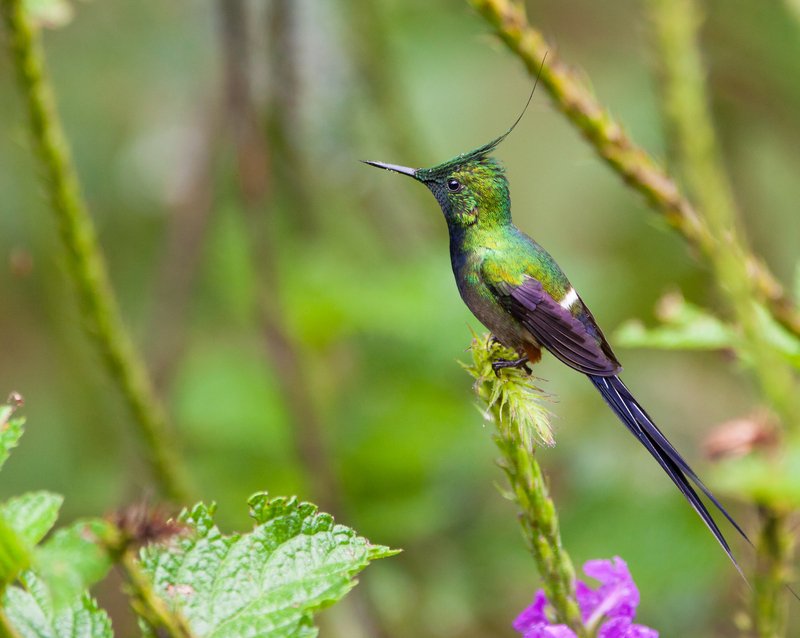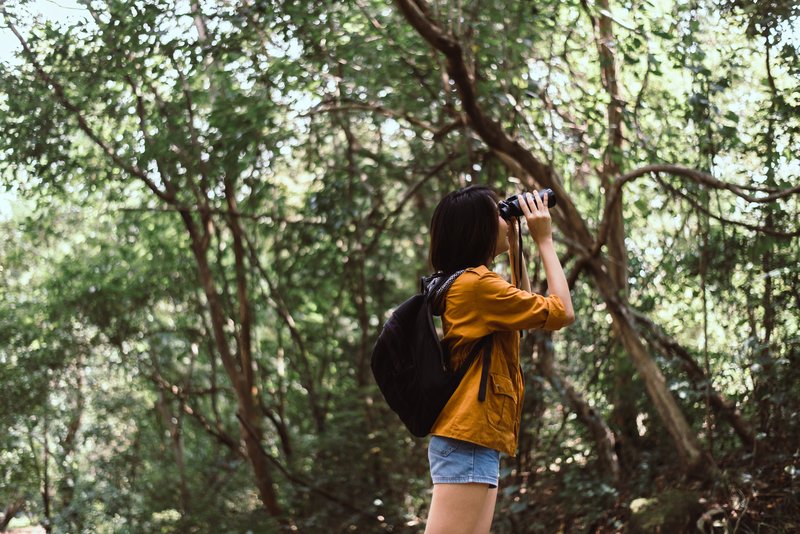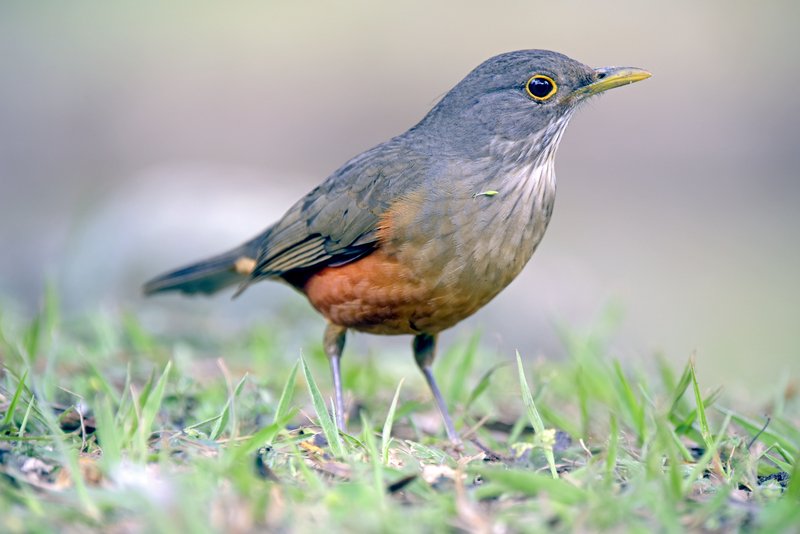Birdwatching goes as far back as the late 1880s when the first recorded field guides and practitioners emerged. What started as a small hobby in Great Britain quickly grew in popularity. Now, there are birdwatching destinations in countries worldwide, with nearly none more famous than those in Brazil.
Brazil is one of the best countries for birdwatching. It boasts the highest concentration of endemic birds globally and nearly 2,000 species of birds. In addition, Brazil has six distinct habitats and two seasons that each have their own unique benefits for bird watchers.
Being only behind Colombia in terms of the variety of birds, Brazil holds a wealth of experiences for every bird watcher. Whether you’re searching for one species in particular or want to see as many birds as possible, species are well-documented across the six habitats.
Birdwatching In Brazil
Being the fifth largest country in the world and home to one of the most iconic rainforests, it’s no wonder that Brazil is a popular spot for birds and people alike. Its ecological diversity makes it a draw for many people, bird watchers and otherwise.
Generally speaking, bird watchers are drawn to Brazil for several reasons. First, as already stated, it has the highest concentration of endemic (i.e., native) species in the world, while the Amazon Rainforest holds the highest concentration of bird species in general.
But the birds in Brazil have also developed unique and fascinating behavioral patterns and plumage, which is a dray for many bird watchers.
What Is The Best Place For Birdwatching?
The best places for birdwatching in Brazil depend on the type of birds you want to see. As one would expect from such a large country, there are many different potential spots. However, Brazil is primarily broken up into six significant avian habitats: the Amazon rainforest, Pantanal, Atlantic Rainforest, Cerrado, Pampa, and Caatinga.

Each of these six habitats boasts specific attractions, both in the form of flora and fauna. Below is a quick breakdown of the habitats and types of birds you can expect in each:
- Amazon Rainforest – This region is home to the most diverse collection of birds on the entire planet. If you want to see as many different birds as possible, this is the perfect place. It holds over 1300 species and counting.
- Pantanal – As the largest wetland in the world, Pantanal has an amazing variety of birds, though the selection is not as diverse as that of the Amazon Rainforest. However, the birds are more centralized, meaning you’ll see more birds in less stops.
- Atlantic Rainforest – This habitat has the highest number of endemic birds in the world and holds more than half of Brazil’s native birds. The birds here are also known for their uniqueness, as the region is geographically isolated from other habitats.
- Cerrado – The most extensive woodland and dry forest ecosystem in South America, the Cerrado has enough diversity to rival the Amazon.
- Pampa – This sourthernmost habitat is mostly comprised of grasslands and plains, interspersed with lakes and marshes. In addition to featuring migrant waterbirds as a results of its coastal zone, it features many other species.
- Caatinga – The largest dry forest in South America, Caatinga is characterized by xeric shrubland and small patches of rainforest. This contradictory mixture creates a home for a wide variety of different birds.
There are ample opportunities to go birdwatching in these and other places in Brazil. Besides traveling and birdwatching as an individual or as part of a local group, the tourism industry offers a variety of travel packages centered around birdwatching.
Many people assume that the Pantanal is located inside the Amazon Forest, which is not the case. If you want to know precisely where the Pantanal is located, take a look at this post we made!
Birds Native To Brazil
There are nearly 2,000 species that reside in Brazil, but less than 300 of these are actually native. Out of the species endemic to Brazil are threatened by habitat loss and are listed as threatened or near-threatened. Several are now extinct in the wild and only available in captive populations.
Some endemic species include the Yellow-legged Tinamou (Crypturellus noctivagus), East Brazilian Chachalaca (Ortalis araucuan), Buff-browed Chachalaca (Ortalis superciliaris), White-crested Guan (Penelope pileata), Blue-eyed ground Dove (Columbina cyanopis), and Saw-billed Hermit (Ramphodon naevius).
Commonly Found Birds In Brazil
Some of Brazil’s most common bird species include Tinamous, Chachalacas, Guans, Curassows, Cuckoos, Nightjars, Potoos, Swifts, Hermits, Thorntails, Rails, Crakes, Piculets, Parakeets, Toucans, and Parrots, among many others.

Out of the thousands of birds species found in Brazil, some are endemic and nearly extinct; others are found across many other countries besides Brazil and have thriving populations.
Within Brazil’s six primary habitats, here are a selection of the birds most commonly found:
- Amazon Rainforest – Tinamous, Screamers, Pintails, Chachalacas, Guans, Curassows, Grebe, Cuckoos, Nighthawks and Nightjars, Potoos, Swifts, Hermits, Thorntails, Starthroats, Sabrewings, Hummingbirds, Puffbirds, Sandpipers, Terns, and Trogons
- Pantanal – Finch, Seedeaters, Tanagers, Cardinals, Grosbeak, Warblers, Blackbirds, Cacique, Oropendolas, Sparrows, Euphonia, Thrush, Wren and Gnatwren, Jays, Greenlets, Flycatchers, Flatbills, Tody, Tityra, and Becards
- Atlantic Rainforest – Guans, Cuckoos, Nighthawks and Nightjars, Swifts, Hermits, Hummingbirds, Rails, Crakes, Terns, Petrel, Shearwaters, Herons, Egrets, Ibis, Vultures, Kites, Hawks, Owls, Kingfishers, Puffbirds, Toucans, Falcons, and Macaws
- Cerrado – Motmots, Puffbirds, Nunlets and Nunbirds, Jacamars, Woodpeckers, Macaws, Leaftossers, Woodcreepers, Xenops, Thornbirds, Cotingas, Purpletufts, Becards, Elaenia, Pewees, Attilas, Greenlets, Jays, Swallows, Thrush, Pipits, and Euphonia
- Pampa – Teals, Doves, Plovers, Sandpipers, Gulls, Terns, Albatross, Prions, Shearwaters, Antshrikes, Antwrens, Antpittas, Woodcreepers, Foliage-gleaners, Spinetails, Manakins, Tyrannulets and Tyrants, Flycatchers, Jays, Swallows, Sparrows, Wrens, and Thrush
- Caatinga – Guans, Cuckoos, Crakes, Rails, Plovers, Skua, Jaegers, Terns, Petrels, Herons, Kites, Hawks, Owls, Puffbirds, Jacamars, Toucans, Woodpeckers, Caracaras, Parakeets, Parrotlets, Macaws, Antshrikes, Antbirds, Antwrens, and Gnateaters
Keep in mind this is neither a comprehensive nor exhaustive list due to the sheer number of species in each geographic area.
Suppose you’re looking for a particular bird species, such as the Hyacinth Macaw, or a specific type of bird, such as endemic species or Thorntails. In that case, it’s best to research which habitat would provide you with the most viewing potential.
The avian inhabitants of these regions are well documented, so you should be able to identify your desired travel area reasonably quickly. Chances are, it will either be on a well-worn birdwatching route or included as part of a birdwatching travel/ tour package.
Specific Locations For Birdwatching In Brazil
Brazil is more than three million square miles. Even broken up into six primary geographic areas, that’s still thousands of miles and hundreds of bird species. It’s not feasible to cover such a large swath of land, especially if you’re going by yourself or as part of a group instead of as a guided tour.
Instead of just selecting a habitat to go birdwatching in, it may be more efficient to look into birdwatching at specific destinations. So here are some more particular locations and the birds you can find within them, including state or national parks, towns, and more:
Amazon Rainforest
- Amazonia National Park – Golden Parakeet, Vulturine Parrot and White-bellied Parrot, Crimson-bellied Parakeet, Harpy and Crested Eagle, Cryptic Forest-Falcon, White crested Guan, Dark-winged Trumpeter, Fiery-tailed Awlbill, and Gould’s Toucanet
- São Gabriel da Cachoeira – Tawny-tufted Toucanet, Maroon-tailed Parakeet, Rufous-winged Ground-Cuckoo, Pearly Antshrike, Chestnut-created and Gray-bellied Antbird, Yellow-throated and Antwren
- Manaus City – Guianan Cock-of-the-Rock, Black manakin, Northern Slaty-Antshrike, Pale-bellied Mourner, Guianan Toucanet, Common scale-backed Antbird, Guianan Puffbird, Pompadour Cotinga, and Green Aracari
- Carajás National Forest – Harpy and Crested Eagle, Hyacinth Macaw, Silky-tailed Nightjar, Peruvian Recurvebill, Opal-crowned Manakin, Hellmayr’s Parakeet, Dark-winged Trumpeter, Bare-faced Curassow, and Gould’s Toucanet
- Borba – Bald Parrot, Crimson-bellied Parakeet, Fiery-tailed Awlbill, Brown-breasted Barbet, Hoffmann’s Woodcreeper, White-breasted Antbird, Buff-cheeked Tody Flycatcher, Rufous-faced Antbird, and Red-necked Aracari
- Tabatinga – Elusive-Antpitta, Black-tailed Antbird, Rio Suno Antwren, and Gray Wren
- Pará – Golden Parakeet, Vulturine Parrot, and Harlequin and Pale-Faced Antbird
- Roraima – Sun Parakeet, Rio Branco Antbird, and Hoary-throated Spinetail
- Anavilhanas – Klage’s Antwren and Cherrie’s Antwren
- Alta Foresta – Cryptic Forest-Falcon, Crimson-bellied Parakeet, Kawall’s Parro, Black-girdled Barbe, Bare-eyed Antbird, Tooth-billed Wren, and Flame-crested Manakin.
Pantanal
- Pantanal Matogrossense National Park – Hyacinth Macaw, Monk Parakeets, Barred Antshrike, Jabirus, Greater Rhea, Capped Heron, Great Egret, Amazon kingfishers, Ringed Kingfishers, Grey-crested cacholote, and Helmeted Guineafowl
- Chapada dos Guimarães National Park – Collared Cresentchest, Dot-eated Coquette, Rufous-sided Pygmy Tyrant, Blue Finch, and Coal-crested Finch
- Emas National Park – Goias, Yellow-faced parrot, white-winged nightjar, and seedeaters
Atlantic Rainforest
- Itatiaia National Park – Black-and-Gold Cotinga, Itatiaia Thistletail, Rufous-tailed Antbird, Rufous-backed Antvireo, White-bearded Antshrike and Black-capped Piprites
- Serra dos Orgoas National Park – Hooded Berryeater, Gray-winged Cotinga, Three-toed Jacamar, and Elegant Mourner
- Intervales State Park – Black-throated Piping Guan, Long-Trained Nightjar, Swallow- tailed Cotinga, and Atlantic Royal Flycatcher
- Espirito Santo – Red-browed Parrot, Long-tailed Potoo, Banded Cotinga, Black-headed Berryeater, Cherry-throated Tanager, Plumbeous Antvireo, Weid’s Tyrant Manakin, Russet-winged Spadebill and Red-billed Curassow
- Porto Seguro – Red-browned Parrot, White-winged Potoo, Hook-billed Hermit, Bahia Antwren, and Banded Cotinga
- São Paulo – Slaty Bristefront, Red-eyed Thornbill, Buff-throated Purpletuft, Spotted Bamboo Wren, and Fork-tailed Tody-Tyrant
- Santa Catarina – Sickle-winged Nightjar, Marsh Antbird, Hooded Berryeater, Wetland Tapaculo, Canebrake Groundkeeper, and Kaempfer’s Tody-Tyrant
Cerrado
- Serra de Canastra – Lesser Nothura, Crowned Eagle, Brazilian Merganser, Campo miner, Brasilia Tapaculo, and Cock-tailed Tyrant
- Serra de Cipó – Hyacinth Visorbearer, Cipo Canastero, Cenerous Warbling Finch, and Blue Fnich
- Caraça – Serra Antwren, Buiscutate Swift, and Cinnamon-vented Piha
- Brasília National Park – Planalto Foliage-gleaner and White-striped warbler
Pampa
- Lagoa do Peixe National Park – Dot-winged Crake, Chilean and Andean Flamingo, Ringed Teal, Black-headed Duck, Black-necked and Coscoroba Swans, Curve-billed Reedhaunter, Giant Wood-Rail
- Canastra National Park – Lesser Nothura, Dwarf Tinamou, Crowned Eagle, Giant Snipe, Red-and-white Crake, Red-spectacled, Vinaceous-breasted and Yellow-faced Parrot, and White-winged and Sickle-winged Nightjar
- Emas National Park – Stripe-breasted Starthroat, Brazilian Merganser, Mottled Piculet, Biscutate Swift, Striolated and Araucaria Tit-Spinetail, Straight-billed Reedhaunter, Planalto Foliage-gleaner, Long-tailed Cinclodes, and Campo Miner
- Sao Fransisco de Paula – Vinaceous-breasted Parrot, Mottled Piculet, Long-tailed Cinclodes, Striolated and Aracaria Tit Spinetail, Chestnut-backed Tanager, and Saffron-cowled Blackbird
Caatinga
- Bahia State – Lear’s Macaw, Sincora Antwren, Bahia Tapaculo, Diamantina Tapaculo, Pink-legged Graveteiro, and Bahia Tyrannulet
- Pau Brasil National Park – Harpy eagle, red-billed curassow, Atlantic black-breasted woodpecker, black-headed berryeater, and ochre-marked parakeet
- Boa Nova National Park – Slender Antbird, Caatinga Antwren, Striated Softail, Bahia Spinetail, Fork-tailed Tody Tyrant, and Bahia Tyrannulet
- Chapada do Araripe – White-browed Guan, White-browed Antipitta, Bearded Bellbird, Great Xenops, and Tawny Piculet
- Murici (Alagoas) – Long-tailed Woodnymph, Alagoas Foliage-gleaner, Alagoas Foliage-gleaner, Alagoas Antwren, Alagoas Tyrannulet, Seven-colored Tanager, and Pintos Spinetail
These locations are rife with spectacular birds and other local flora and fauna. Many species are present across the majority of or all six of these habitats, although certain birds are only available within one area.
What Is The Best Time For Birdwatching?
Typically, the best time to watch birds is between sunrise and 11:00 AM during the spring and summer months. This period is when the majority of birds are most active, although there are exceptions. Birds’ activity may also be affected by the weather, geographic factors, or species-specific behavior. For example, owls, potoos, nightjars, Pauraques, and nighthawks are more active during dusk and night.
It’s essential to do research on the region before going birdwatching. Brazil is affected by the distinct four seasons (spring, summer, fall, and winter) and has its own rainy and dry seasons, affecting birdwatching. The temperature may also limit how many birds you’re able to see.
The wet season runs from November/ December through June, while the dry season runs from July to October/ November. Generally, it’s best to birdwatch during the dry season since animals flock to the few lovely pools of water still standing. However, there are also drawbacks to birdwatching during the dry season, just as there are benefits to going during the wet season.
If you’re going as an individual or part of a local group, you can choose which season suits you best. For bird watchers who prefer to go as part of a tour, most tour companies offer travel packages during either the rainy or dry season.
Pros and Cons Of Birdwatching During Brazil’s Rainy And Dry Seasons
Birdwatching during Brazil’s wet season has both pros and cons, as does birdwatching during the dry season. The rain brings better vantage points, accessibility, and fauna variety. The dry season brings more amenable hiking conditions, concentrated populations of birds, and the addition of migratory birds.
Each of these benefits is expanded on below.
The benefits of the wet season are:
- Higher water levels bring you closer to the rainforest canopy where many birds rest, giving you better vantage points and clearer viewing
- Smaller lakes and rivers which would ordinarily be inaccessible are now open, meaning the birds therein are also able to be viewed
- Riverine plants and fruits come into bloom, which entices birds much closer to the river and ground than they would otherwise venture
But the dry season has its benefits, which are:
- There are less mosquitoes and other pests to distract you during hiking, waiting, and birdwatching. This can also reduce the risk of disease.
- Fish populations are concentrated in the remaining areas with water, which makes it easier to view birds whose diets consist primarily of fish or aquatic-based foods.
- Migratory birds are more common during the dry season, meaning you’ll be able to view these species and residential birds.
Most birding tours include both day and night trips so that watchers can spot as many species as possible. This is also a sound strategy if you’re traveling as an individual or part of a smaller, guided group.
Main Equipment To Go Birdwatching
Compared to other hobbies, birdwatching does not require excessive equipment. Additionally, most of this “required” equipment is widely available and affordable.

The main equipment you’ll need to go birdwatching is as follows:
- Binoculars – Perhaps only the true required equipment, you’ll need a good pair of binoculars to track birds. There are a variety of styles that range in price from $150 to over $1,000. Try different styles to find the kind that work best for you.
- Field Guide – Unless you’re adept at memorizing different types of birds, you’ll need a field guide. Using this, you’ll be able to identify which species you spot. There are both international, national, regional, and local field guides available.
- Birding Apps – For those who want to travel lighter, there are apps you can download on your phone that replace traditional field guides. Like the guides, they list birds within a specific geographic area to help you identify the species you see.
- Appropriate Clothing – Sturdy boots or shoes and a hat to keep the sun off your face will go a long way toward making your birdwatching more comfortable. Additionally, it’s also wise to prepare for inclement weather, such as rain or the cold.
If you’re interested in birds that are active primarily at night, such as owls, then investing in a pair of night vision binoculars or monoculars is advisable. Alternatively, that should be a feature you prioritize when choosing a pair of regular binoculars.
Practical Equipment For Birdwatching
There are very few necessities when it comes to birdwatching, binoculars being the most critical piece of equipment. But beyond your binoculars, field guide, and appropriate clothing, there are several other types of equipment that can make your experience better overall.
Though these pieces of equipment aren’t strictly necessary, they are practical and will help you immensely:
- Binocular Strap or Harness – Using a neck strap or harness for your binoculars keeps your hands free and also reduces the chance of you accidentally damaging your binoculars by dropping them.
- Checklist – Similar to a field guide, a checklist lists all the bird species in one particular area. Unlike a field guide, checklists only include a bird’s name and, sometimes, a picture. As you see each bird, you can mark them off the checklist.
- Backpack or Bag – A bag is one of the most practical and cheap pieces of equipment you’ll need. It can carry your field guide, checklist, extra socks, water, and any other objects you bring along. Some backpacks come with built-in storage for cameras.
- Journal and Pen – Bringing a journal and pen can help you keep track of the birds you see and any other observations you make while birdwatching or hiking.
- Spotting Scope – While binoculars will help you see from a distance, they may not be powerful to see birds that are very far away. A spotting scope can cover these distances so that you can see the bird in all its detail.
- Camera or Photography Equipment – Many bird watchers enjoy taking photographs of the birds they spot, especially if they’re after a particular species. A camera will capture and preserve your experience.
If you’re going to be on an extended hike or trip, it would also be wise to take a water filter, a first aid kit, pest control spray, and extra snacks to make sure you’re prepared for emergencies. These will ensure you are hydrated, healthy, and have energy.
Alternatives To Binoculars For Birdwatching
Though binoculars are practically essential for birdwatching, they can quickly become expensive depending on the style, brand, and features. As a result, digiscoping has more recently emerged as an alternative to binoculars and camera equipment.
Digiscoping involves placing a spotting scope over your smartphone camera, thus essentially turning your phone into an advanced birding camera. Several different pieces of equipment are attached to your phone to accomplish this.
- Monocular With Smartphone Holder – This monoscope (essentially half of a binocular) comes with a smartphone holder to keep your phone anchored. Though it’s recommended you use it in conjunction with a tripod, you can freehand it to take photos.
- Smartphone Telephoto Lens – These kits come with a telephoto lens that enhances your smartphone camera and allows it to zoom in better, in addition to coming with a pocket-sized tripod that attaches to your phone.
In addition to using digiscoping equipment, you can also invest in alternatives such as trail cameras. You can place these around your property and check the footage later instead of birdwatching in real-time. With these cameras, you’ll also get a chance to look at the local wildlife in your areas, such as deers and other animals.
Equipment For Birdwatching In Your Backyard
Birdwatching doesn’t require you to travel across the country or hike through the woods. Instead, many bird watchers enjoy their hobby from the comfort of their homes by making their backyard or property an oasis for birds.
If you want to entice birds to come to you instead of going to them, here’s a list of equipment to draw them closer:
- Bird Feeders – Food is a powerful motivator for birds. With the right feeder and seed mix, you’ll be able draw in a variety of birds or a particular type. There are squirrel-proof feeders available for those who struggle with other local wildlife.
- Bird Houses – You’ll have more opportunity to watch birds if they reside on your property. Investing in traditional bird houses, nest boxes, and winter roost boxes will keep birds in your yard year-round.
- Bird Baths – A bird bath is an aesthetically pleasing and effective way to attract birds. Remember that birds prefer moving water versus stagnant. Consider adding equipment such as de-icers and built-in heaters for the cooler months.
Watching your local birds and other fauna can be a relaxing experience, in addition to helping you practice your identification skills. The more familiar you are with the birds in your area, the easier it will be to identify any new species.
What Is The Bird Of Brazil?
The national bird of Brazil is the Rufous-bellied thrush (Turdus rufiventris), or the Sabiá-laranjeira in Portuguese. It became the national bird in 2002 following a decree from former President of Brazil, Fernando Henrique Cardoso.

Though different countries can share the same national animal, only Brazil boasts the Rufous-bellied thrush as its national bird. We made a whole post on the Rufous-bellied thrush, so if you want to know more about it, take a look right here!
The Rufous-bellied thrush has a Least Concern conservation status and can be found widely throughout southern and eastern Brazil. It’s also found in neighboring countries such as Bolivia, Argentina, Paraguay, and Uruguay.
Final Thoughts: Tips To Remember For Birdwatching In Brazil
Brazil is one of the most rewarding destinations for birdwatching. The exotic and varied species make it a draw for beginners and veterans alike. But before you go globetrotting, remember to do your research. Narrow down where and when you want to travel, as these decisions will affect which species you’re able to see.
Brazil has six primary habitats. Some species span these habitats, while others are strictly limited to one or two geographic areas; some are present year-round, while others are migratory and only present for a few short months.
Additionally, remember to choose your equipment carefully. You’ll need binoculars, at the very least, and potentially a great deal more. As a precaution, it’s always wise to bring a backup pair of binoculars when traveling.
Before your flight to Brazil, research the airlines carefully. Find out whether you’ll have to check your equipment or if it will fit (or is allowed) in a carry-on. For any checked equipment, consider how the changes in air pressure will affect it.
While you’re here, I think we might interest you with these:
9 Best Places to Swim with Dolphins in Brazil – Wanna check out the best places to spot and swim with the famous Brazilian pink dolphin? Take a look at our post!
Visiting The Amazon While In Brazil? Here’s What You Need To Know – Visiting the Amazon is a lifetime experience, but there are a few things you need to know before even getting there. Luckily for you, we got all the main info for you right here!
A Backpackers Guide To Brazil – Planning a big adventure while backpacking throughout Brazil? Here’s everything you need to know.
Cover Photo: the Brazilian rufous bellied thrush – Credit: ID 65476009 © Carlos Pinheiro | Dreamstime.com
